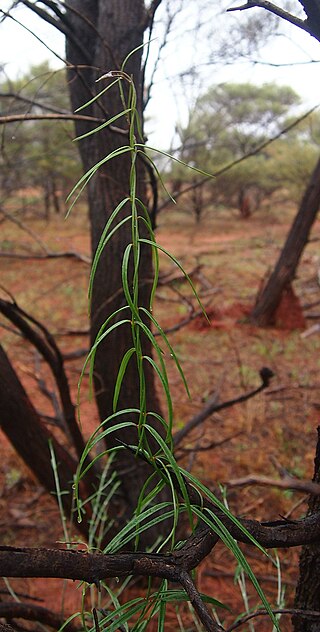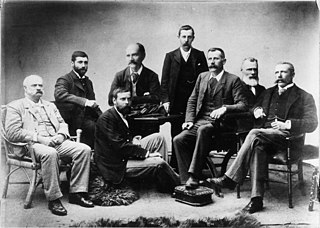
The Dreaming, also referred to as Dreamtime, is a term devised by early anthropologists to refer to a religio-cultural worldview attributed to Australian Aboriginal beliefs. It was originally used by Francis Gillen, quickly adopted by his colleague Baldwin Spencer and thereafter popularised by A. P. Elkin, who, however, later revised his views.

Hermannsburg, also known as Ntaria, is an Aboriginal community in Ljirapinta Ward of the MacDonnell Shire in the Northern Territory of Australia, 125 kilometres (78 mi); west southwest of Alice Springs, on the Finke River, in the traditional lands of the Western Arrarnta people.

Sir Walter Baldwin Spencer, commonly referred to as Baldwin Spencer, was a British-Australian evolutionary biologist, anthropologist and ethnologist. He is known for his fieldwork with Aboriginal peoples in Central Australia, contributions to the study of ethnography, and academic collaborations with Frank Gillen. Spencer introduced the study of zoology at the University of Melbourne and held the title of Emeritus Professor until his death in 1929. He was elected a Fellow of the Royal Society in 1900 and knighted in 1916.
The Alyawarre, also spelt Alyawarr and also known as the Iliaura, are an Aboriginal Australian people, or language group, from the Northern Territory. The Alyawarre are made up of roughly 1,200 associated peoples and actively engage in local traditions such as awelye painting.
Carl Friedrich Theodor Strehlow was an anthropologist, linguist and genealogist who served on two Lutheran missions in remote parts of Australia from May 1892 to October 1922. He was at Killalpaninna Mission in northern South Australia, from 1892 to 1894, and then Hermannsburg, 80 miles (130 km) west of Alice Springs, from 1894 to 1922. Strehlow was assisted by his wife Friederike, who played a central role in reducing the high infant mortality which threatened Aboriginal communities all over Australia after the onset of white settlement.

The Arrerntepeople, sometimes referred to as the Aranda, Arunta or Arrarnta, are a group of Aboriginal Australian peoples who live in the Arrernte lands, at Mparntwe and surrounding areas of the Central Australia region of the Northern Territory. Many still speak one of the various Arrernte dialects. Some Arrernte live in other areas far from their homeland, including the major Australian cities and overseas.

A kurdaitcha, or kurdaitcha man, also spelt gadaidja, cadiche, kadaitcha, karadji, or kaditcha, is a type of shaman and traditional executioner amongst the Arrernte people, an Aboriginal group in Central Australia. The name featherfoot is used to denote the same figure by other Aboriginal peoples.

The Kaytetye, also written Kaititya, and pronounced kay-ditch, are an Aboriginal Australian people who live around Barrow Creek and Tennant Creek in the Northern Territory. Their neighbours to the east are the Alyawarre, to the south the Anmatyerre, to the west the Warlpiri, and to the north the Warumungu. Kaytetye country is dissected by the Stuart Highway.

Leichhardtia australis, commonly known as the bush banana, silky pear or green vine is an Australian native plant. It is found in Central Australia and throughout Western Australia. It is a bush tucker food used by Indigenous Australians.
Charlotte Waters was a tiny settlement in the Northern Territory of Australia located close to the South Australian border, not far from Aputula. It was known for its telegraph station, the Charlotte Waters Telegraph Station, which became a hub for scientists travelling in central Australia in the late 19th and early 20th century. Aboriginal artist Erlikilyika, known to Europeans as Jim Kite, lived there. Only a ruin remains today.

The Horn Scientific Expedition was the first primarily scientific expedition to study the natural history of Central Australia, sponsored by three Australian universities. It took place from May to August 1894, with expedition members first traveling by train from Adelaide to the railhead at Oodnadatta in South Australia, then using camels for transport to traverse over 3000 km of largely uncharted country from Oodnadatta through the Finke River basin to Alice Springs and the Macdonnell Ranges in the Northern Territory.
Moritz Freiherr von Leonhardi was a German anthropologist.
The Anmatyerr, also spelt Anmatyerre, Anmatjera, Anmatjirra, Amatjere and other variations) are an Aboriginal Australian people of the Northern Territory, who speak one of the Upper Arrernte languages.
The Binbinga, also pronounced Binbinka, are an Indigenous Australian people of the Northern Territory of Australia.
Illamurta Springs Conservation Reserve is a protected area in the Northern Territory of Australia in the locality of Ghan about 42 kilometres (26 mi) south of Hermannsburg and 140 kilometres (87 mi) west of Alice Springs. The southern foothills of the James Range and the permanent spring from which the reserve takes its name are found within the reserve.

The Alice Springs Telegraph Station is located within the Alice Springs Telegraph Station Historical Reserve, four kilometres north of the Alice Springs town centre in the Northern Territory of Australia. Established in 1872 to relay messages between Darwin and Adelaide, it is the original site of the first European settlement in central Australia. It was one of twelve stations along the Overland Telegraph Line.

The Arabana, also known as the Ngarabana, are an Aboriginal Australian people of South Australia.

The Luritja or Loritja people, also known as Kukatja or Kukatja-Luritja, are an Aboriginal Australian people of the Northern Territory. Their traditional lands are immediately west of the Derwent River, that forms a frontier with the Arrernte people, with their lands covering some 27,000 square kilometres (10,300 sq mi). Their language is the Luritja dialect, a Western Desert language.

Erlikilyika, known to Europeans by the name Jim Kite or Jim Kyte or Jim Kite Penangke, was an Aboriginal Australian sculptor, artist and anthropological interpreter. He was an Arrernte man, born into the Southern Arrernte or Pertame language group in Central Australia. He was the first Central Australian artist to be nationally recognised for his artistic talent, in particular his carvings of animals in soft stone, illustrations and sculptures, after an exhibition of his work was held in Adelaide, South Australia in 1913.
Patrick Michael Byrne (1856–1932), also known as Paddy or Pado, was an Australian telegraph operator, anthropologist and natural scientist who worked at the remote Charlotte Waters telegraph station in central Australia for 50 years. He was a keen self-taught scientist who collected specimens and corresponded extensively with biologist and anthropologist Walter Baldwin Spencer. He also worked with anthropologist Francis James Gillen at Charlotte Waters, and was a friend of and advocate for the local Arrernte people.












